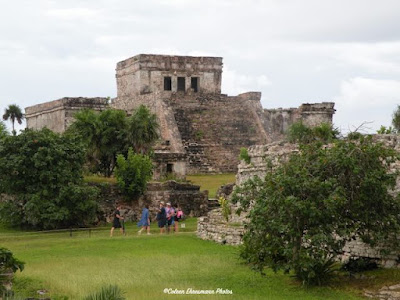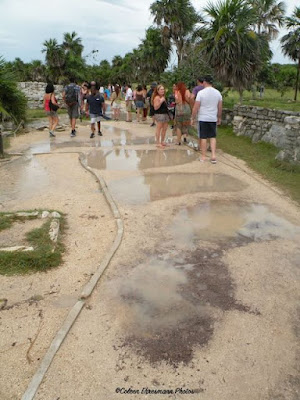The three oldest E family members escaped to tour Tulum on Thursday. The other adults have been there a couple of times, but it was a first for the three of us. Rain had been forecasted before we left on the vacation trip, but to us, tropical rain meant it might rain for 15 minutes and be done. We did not count on Tropical Storm Lisa hanging around for 3 days and interfering with our plans. No big deal though as we purchased rain ponchos at the market before we entered Tulum and prior to the downpour.
Hubby captured the sunrise this morning as we waited for our tour bus.
One of five narrow entrances through the rock wall into the ancient Mayan city of Tulum. We had to bend over/duck to enter the tunnel.
umbrellas and ponchos for some of us
first glimpse of The Castle
The Castle was the most imposing and important building in the city. Its purpose was two fold; for religious and ceremonial purposes and for astrological and lunar purposes.
Some of the red color/paint used to decorate the buildings can still be seen in the ruins of this building. The red and black paint came from soil and minerals. The green and blue colors came from plants.
According to our guide, about 400 families lived within the stone walled community. These people were the elite; the nobility, the educated, the officials, the professionals, etc. The common people lived outside the walled city. Women started bearing children at age 13 and were often deceased by age 35 because they bore 13+ children. Some of the upper class women may have lived beyond the age of 60 because they had better living conditions, access to health professionals and better food.
The Temple of the Paintings (Temple of the Fresnos) is a temple within a temple. The decorations on the upper level temple are red hand prints. The lower level temple has murals and masks decorating the facade. Remains of frescos can also be seen inside the lower temple walls. It is not possible to enter any of the buildings. It also has modern supports to keep it from collapsing like some of the other stone buildings. It is one of three major structures in the city.
Temple of the Descending God, the third of the three major structures.
The temple gets its name from the relief above the door. There are several similar depictions throughout the ancient city, including one on the Temple of the Paintings.
Tulum's natural defense is the ocean. The city is built on a cliff, 400 meters above sea level according to out tour guide. Because of Tropical Storm Lisa, it was difficult to see the barrier reef.
This is the backside of The Castle. The only windows are the two small ones on the top level that brought the morning light. The Mayan people built and lived in the city between the thirteen and fifteenth centuries and began to disappear when the Spanish arrived in Mexico in the late 1500s.
Lots of seaweed had been washed up during this storm. But someone else told us this area has lots of seaweed, always.
The small round window on the upper level was important two times during the year; on summer solstice day and winter solstice day. The light coming in the window displayed a star on the temple/castle wall. (A star like that of depictions of the Christmas Star seen by the sheperds and wise men.)
We noticed a couple of iguanas on the walls of one of the building ruins. (At least I think they are iguanas.) We also saw staff and police remove a very long non-venomous snake from the walking path on our return to the tour bus. Sorry. No photo.
The puddles on the pathway give an idea of the soil and the run off in the city.
The city of Tulum was also known as Zama, meaning dawn, as it was the first place to receive the morning sun in this part of the country. Tulum was a commercial port for the redistribution of local and foreign products important to the Mayan culture. Obsidian was a prized trade item. Everyday life was intertwined with politics, religious rituals, art, and astronomy. The planet Venus, the morning and night star, was very important to the people in this community.
We were able to remove our ponchos about half way through our tour. No sunshine and some light sprinkles now and then.
This is the third Mayan city we have toured. In 2001 we toured Chichén Itza when climbing the steps of the main temple/castle was still allowed. In 2018 we visited Chacchoben Mayan Ruins near the Mexican city of Mahahaul about 100 miles from Tulum.
We visited a Cenote after our Tulum tour. That post is for another day.




















No comments:
Post a Comment
Thanks for your comments!